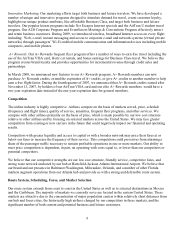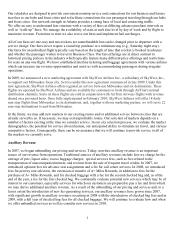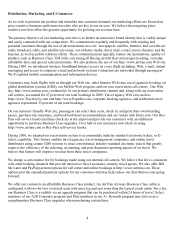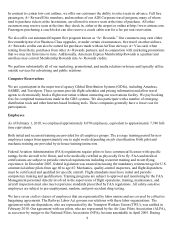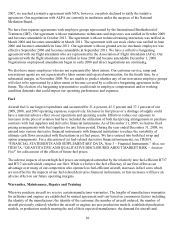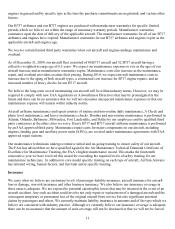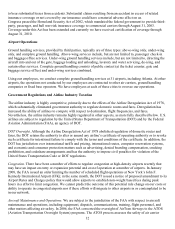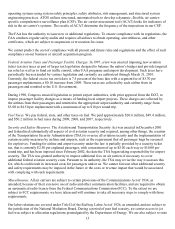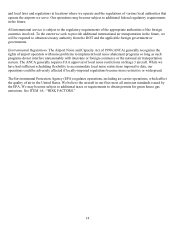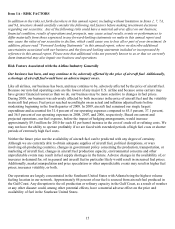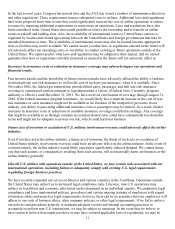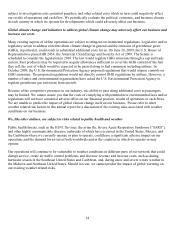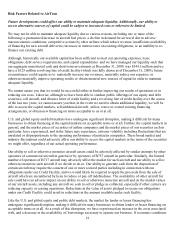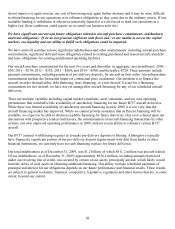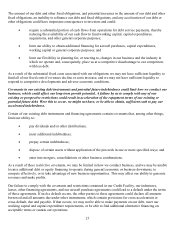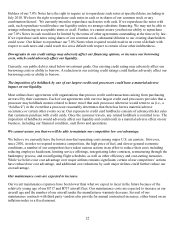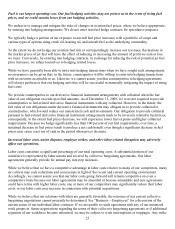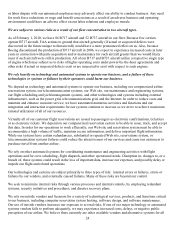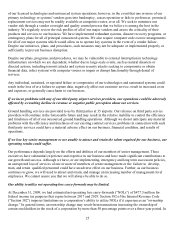Airtran 2009 Annual Report Download - page 24
Download and view the complete annual report
Please find page 24 of the 2009 Airtran annual report below. You can navigate through the pages in the report by either clicking on the pages listed below, or by using the keyword search tool below to find specific information within the annual report.15
Item 1A - RISK FACTORS
In addition to the risks set forth elsewhere in this annual report, including without limitation in Items 1, 7, 7A,
and 9A, investors should carefully consider the following risk factors before making investment decisions
regarding our securities. Any of the following risks could have a material adverse effect on our business,
financial condition, results of operations and prospects, may cause actual results, events or performances to
differ materially from those expressed in any forward-looking statements we make in this annual report and
may cause the value of our securities to decline, which could cause you to lose all or part of your investment. In
addition, please read “Forward-Looking Statements” in this annual report, where we describe additional
uncertainties associated with our business and the forward-looking statements included or incorporated by
reference in this annual report. Please note that additional risks not presently known to us or that we currently
deem immaterial may also impair our business and operations.
Risk Factors Associated with the Airline Industry Generally
Our business has been, and may continue to be, adversely affected by the price of aircraft fuel. Additionally,
a shortage of aircraft fuel would have an adverse impact on us.
Like all airlines, our business has been, and may continue to be, adversely affected by the price of aircraft fuel.
Because our non-fuel operating costs are the lowest of any major U.S. airline and because some carriers may
have greater financial resources than we do, our business may be more sensitive to changes in fuel prices.
During 2008, our business was adversely affected by both increases in the price of aircraft fuel and the volatility
in aircraft fuel prices. Fuel prices reached record highs on an actual and inflation adjusted basis before
moderating beginning in the fourth quarter of 2008. In 2009, aircraft fuel remained our single largest
expenditure and accounted for 31.4 percent of our operating expenses compared to 45.5 percent, 37.1 percent,
and 36.5 percent of our operating expenses in 2008, 2007, and 2006, respectively. Based on current and
projected operations, our fuel expense, before the impact of hedging arrangements, would increase
approximately $9.5 million for 2010 for each $1 per barrel increase in the cost of crude oil or refining costs. We
may not have the ability to operate profitably if we are faced with extended periods of high fuel costs or shorter
periods of extremely high fuel costs.
Neither the future price nor the availability of aircraft fuel can be predicted with any degree of certainty.
Although we are currently able to obtain adequate supplies of aircraft fuel, political disruptions, or wars
involving oil-producing countries, changes in government policy concerning the production, transportation, or
marketing of aircraft fuel, changes in aircraft fuel production capacity, environmental concerns and other
unpredictable events may result in fuel supply shortages in the future. Adverse changes in the availability of, or
increases in demand for, oil in general and aircraft fuel in particular likely would result in increased fuel prices.
Additionally, market manipulation and price speculation or other unpredictable events may result in higher fuel
prices, increases volatility, or both.
Our operations are largely concentrated in the Southeast United States with Atlanta being the highest volume
fueling location in our network. Approximately 84 percent of our fuel is sourced from aircraft fuel produced in
the Gulf Coast. Any disruption to the oil production or refinery capacity in the Gulf Coast, as a result of weather
or any other disaster could, among other potential effects, have a material adverse effect on the price and
availability of fuel in the Southeast United States.



